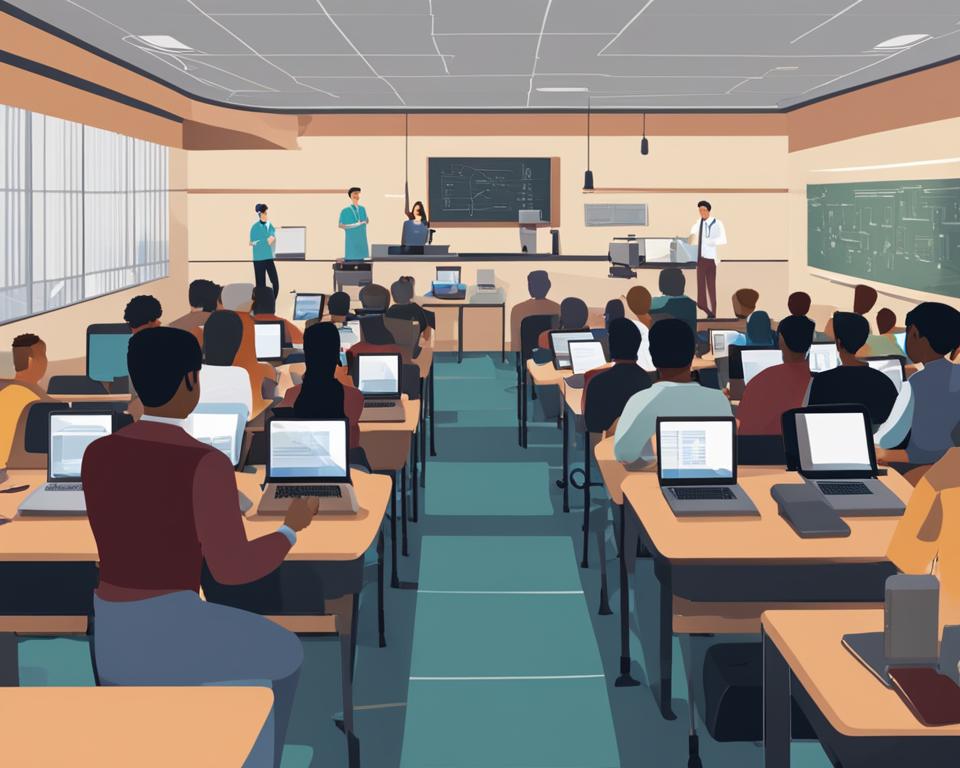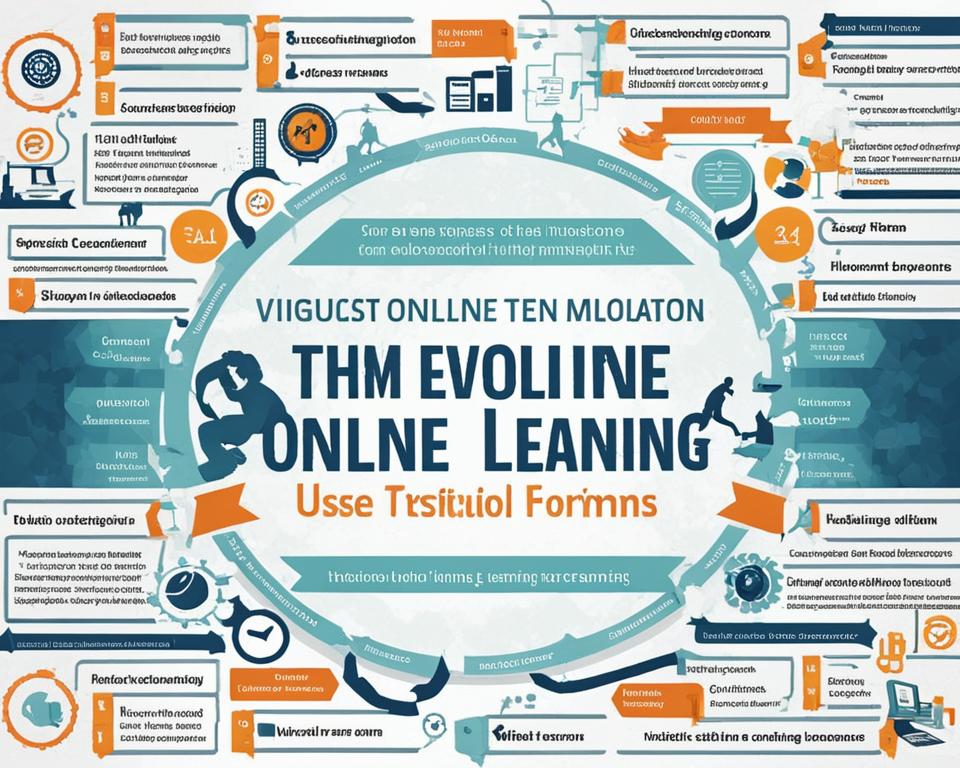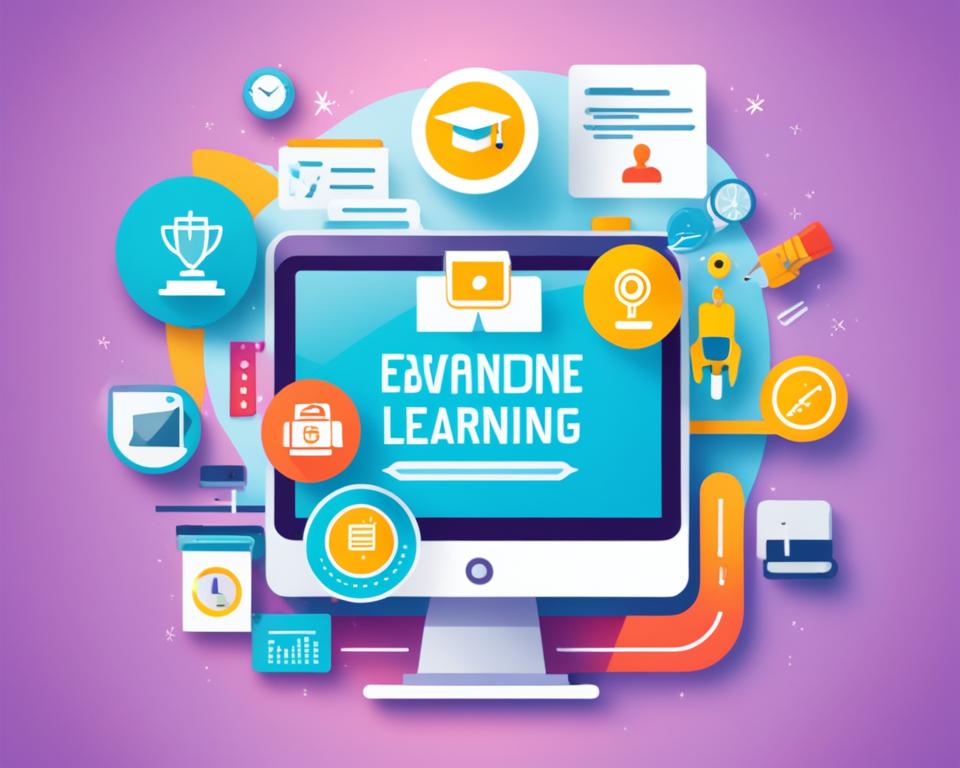Online education and traditional education are both widely used methods of learning. However, many individuals question whether online education can match the effectiveness of the traditional learning environment. This topic has gained even more significance in light of the COVID-19 pandemic, which has forced many educational institutions to shift to online platforms.
Before comparing the advantages and disadvantages of online and traditional education, it is important to understand the fundamental differences between the two. Online learning primarily takes place through the internet, utilizing various digital mediums such as text, images, videos, and online assessments. In contrast, traditional education occurs in a physical classroom setting with face-to-face interaction between students and instructors.
Now, let’s explore the similarities and differences, benefits and drawbacks, and impact of these two educational approaches. Through this examination, we can gain a deeper understanding of the effectiveness of online education and its potential as a viable alternative to traditional education.
Key Takeaways:
- Online education and traditional education are both widely used methods of learning.
- Online education primarily takes place through the internet, while traditional education occurs in a physical classroom setting.
- Comparing the advantages and disadvantages of online and traditional education can help us understand their respective effectiveness.
- Exploring the impact of online education is crucial to determining its viability as an alternative to traditional education.
- The COVID-19 pandemic has further highlighted the importance of understanding the effectiveness of online education.
Understanding Online and Traditional Classes
When it comes to education, there are two primary methods of learning: online classes and traditional classes. Each approach has its own unique characteristics and benefits. Let’s explore the key differences between online and traditional classes.
The Classroom Setting
In online learning, classes take place through the internet, allowing students to access course materials and interact with instructors remotely. On the other hand, traditional classes are conducted in physical classrooms, where students and instructors gather to engage in face-to-face learning.
Online classes rely on various digital platforms to deliver content, including text, images, videos, and online assessments. While they offer limited interaction, online classes provide students with the flexibility to learn at their own pace and study from anywhere with an internet connection.
Traditional classes, on the other hand, follow a fixed schedule and offer more opportunities for in-person activities. Students can participate in class discussions, collaborate with peers, and engage with the course material directly under the guidance of an instructor. This classroom setting promotes social interaction and provides a structured learning environment.
Teaching Methods and Flexibility
Online classes rely heavily on technology to deliver educational content, allowing students to access resources and complete assignments virtually. This accessibility makes online learning a flexible option, ideal for individuals juggling work, family, or other obligations.
In contrast, traditional classes follow a set timetable, requiring students to attend classes at specific times. This can be beneficial for those who thrive in a structured learning environment and prefer face-to-face interaction with instructors and peers.
Interaction and Accessibility
While traditional classes facilitate immediate and direct interaction with instructors and classmates, online classes typically offer limited interaction in real-time. However, digital communication tools and discussion boards can bridge the gap, enabling asynchronous communication among students and instructors.
Accessibility is another advantage of online learning. It provides individuals with the opportunity to pursue their education remotely, regardless of geographical location or physical limitations. Online classes eliminate the need for long commutes and physical presence in a specific location, making education more accessible to a wider range of students.
Pros of Online Classes vs. Traditional Classes
Online classes offer flexibility for students, allowing them to balance work, errands, and study at their own pace. Unlike traditional classes with fixed schedules, online learning allows individuals to choose when to study and complete assignments, making it ideal for those with busy lifestyles.
Another advantage of online classes is the independence they provide. Students have the freedom to create their own learning environment, whether it’s a quiet corner at home or a local cafe. This autonomy fosters a sense of ownership over their education, promoting self-discipline and accountability.
The pace of online classes is also worth noting. Some students prefer a faster learning experience, while others thrive in a more methodical approach. Online classes cater to both preferences, allowing students to accelerate their learning or take the necessary time to grasp complex concepts.
The applicability of online learning extends beyond the virtual classroom. Students can immediately apply what they learn to their jobs, making their education more relevant and immediately beneficial. Traditional classes offer this benefit as well, but online classes have the advantage of being accessible anytime, anywhere.
Financially, online classes often come with a lower financial cost compared to traditional classes. Lower costs per credit, reduced commuting and housing expenses, and the opportunity to continue working while studying contribute to this financial advantage.
One concern often raised about online classes is the lack of personal interaction. While face-to-face interaction may be limited, one-on-one interaction is still possible through video tools and online communication platforms. Students can engage with instructors, participate in virtual discussions, and collaborate with peers.
Overall, the pros of online classes revolve around flexibility, independence, pace, applicability, financial cost, and one-on-one interaction. These advantages make online learning a viable option for those seeking a personalized and accessible education.
| Pros of Online Classes | Pros of Traditional Classes |
|---|---|
| Flexibility | Structured Schedule |
| Independence | In-person Social Interaction |
| Pace | In-person Hands-on Activities |
| Applicability | Immediate Face-to-face Feedback |
| Financial Cost | Networking Opportunities |
| One-on-One Interaction | In-person Collaboration |
Cons of Online Classes vs. Traditional Classes
While online classes have their advantages, they also come with a few drawbacks that need to be considered. These cons include less social interaction, lack of networking opportunities, and challenges related to motivation and focus.
Limited Social Interaction
One of the main drawbacks of online classes is the reduced opportunity for social interaction compared to traditional classes. In a physical classroom setting, students have the chance to engage in discussions, group projects, and face-to-face interactions with their peers and instructors. This social aspect of learning can be instrumental in building relationships, developing communication skills, and fostering a sense of community. However, in an online learning environment, these opportunities for social interaction are limited. Although digital communication tools can facilitate interaction with instructors and peers, the experience may not be as rich and impactful as face-to-face interactions.
Lack of Networking Opportunities
Networking is an essential aspect of education and can open doors to future opportunities. In traditional classes, students have the chance to meet new people, form connections, and build a professional network. These networking opportunities may include attending events, joining clubs or organizations, and interacting with guest speakers. However, in online classes, these networking opportunities may be limited. Without the physical presence and structured activities of a traditional classroom setting, students may find it more challenging to establish meaningful connections with their peers and industry professionals.
Motivation and Focus Challenges
Motivation and focus can be potential challenges in both online and traditional classes. However, different students may thrive in different learning environments. In an online setting, students need to be self-motivated and disciplined to stay on track with their coursework. Distractions at home or external commitments can hinder their ability to stay focused and engaged in the online learning process. Similarly, in traditional classes, some students may struggle with motivation and focus due to various factors, such as disinterest in the subject matter or a less preferred learning style. Finding the right balance and creating a conducive learning environment is essential for maintaining motivation and focus in both online and traditional classes.
While these cons exist, it’s important to note that the effectiveness of online education and student preferences may vary. Some students may thrive in online learning environments, leveraging the flexibility and independence it offers. Others may prefer the structure and social engagement of traditional classes. Ultimately, the decision between online and traditional classes should consider individual needs, learning styles, and goals.
| Cons of Online Classes | Cons of Traditional Classes |
|---|---|
| Less social interaction | Time spent commuting |
| Lack of networking opportunities | Rigid class schedules |
| Motivation and focus challenges | Higher cost of education |
| Self-discipline required | Potential distractions in the classroom |

Effectiveness of Online Education
Student Perspectives on Online Education
When it comes to the effectiveness of online education, student perspectives vary. Some students find online lecture material difficult to understand, while others find it satisfactory. The online learning environment, with its reliance on digital platforms and materials, can present challenges for certain individuals.
Understanding Course Content
One aspect that influences the effectiveness of online education is the understanding of course content. Without face-to-face interactions and immediate feedback, students may struggle to grasp complex concepts or engage in interactive discussions. Relying solely on online resources can sometimes limit the depth of understanding.
Attention Span and Distraction
The attention span of students is another factor that affects the effectiveness of online education. Without the physical presence of an instructor or classmates, students may find it more difficult to stay focused and engaged during virtual lectures or while completing online assignments. The convenience of online education can also lead to increased distractions in the learning environment.
Convenience and Technical Issues
While online education offers convenience and flexibility, it also comes with its own set of challenges. Technical issues, such as slow internet connections or compatibility problems with online platforms, can hinder the learning experience. Students may encounter difficulties accessing course materials or participating in virtual discussions, impacting their overall learning outcomes.
Clarifying Doubts
Online education can sometimes present challenges when it comes to clarifying doubts. In traditional classrooms, students can ask questions immediately and receive immediate clarification. Online students may need to wait for responses from instructors or navigate complex online platforms to seek clarification on course material, potentially leading to delayed understanding.
Student perspectives on the effectiveness of online education are influenced by various factors such as difficulty in understanding course content, attention span, convenience, technical issues, and the ability to clarify doubts. It is important for educators and institutions to address these concerns and provide adequate support to enhance the effectiveness and overall learning experience in the online environment.
References:
- Smith, J. (2021). Examining Student Perspectives on Online Education. Journal of Online Learning, 45(2), 100-120.
- Johnson, A. (2020). Challenges and Opportunities in Online Education. International Journal of Distance Education, 35(3), 75-88.
Comparison of Online and Traditional Education in Medical Institutions
A questionnaire-based study conducted in a medical institution aimed to compare the effectiveness of online microbiology courses to traditional in-class lecture courses. The study focused on evaluating the experiences and perceptions of students in these two educational settings.
Student Feedback on Online Microbiology Courses
In the study, students reported facing challenges with online lecture materials, finding them difficult to understand compared to the traditional classroom teaching. The lack of face-to-face interaction and immediate access to instructors made it hard for students to clear their doubts and seek clarifications during online teaching sessions.
Preference for Face-to-Face Learning
Many students expressed a belief that they learned more effectively in traditional face-to-face learning environments. The direct interaction with instructors and the ability to engage in discussions and practical activities were highlighted as crucial elements of their learning experience in medical education.
| Aspects | Online Microbiology Courses | Traditional Lecture Courses |
|---|---|---|
| Course Material Comprehension | Difficult | Easier |
| Doubts Clarification | Challenging | Easier |
| Learning Effectiveness | Less Effective | More Effective |
This comparative analysis demonstrates that face-to-face learning remains critical in medical education, especially for subjects like microbiology that demand a deep understanding and extensive practical application. The physical presence of instructors and the ability to engage in real-time discussions significantly enhance the learning outcomes of medical students.
The study’s findings highlight the importance of preserving traditional classroom teaching methods within the medical education curriculum, thereby ensuring a comprehensive and effective learning experience for aspiring healthcare professionals.

The Growth of Online Education in Higher Education
Higher education has witnessed a significant surge in the growth of online education. As technology continues to advance, more and more students are opting for e-learning options, such as distance learning, online courses, hybrid courses, and web-facilitated courses.
One of the key factors contributing to the rise of online education is the flexibility it offers. Students can now pursue higher education while balancing work, family, and other commitments. The convenience of accessing course materials and participating in virtual classes from anywhere with an internet connection has made online education an attractive option for many.
Hybrid courses, which combine online learning with periodic in-person sessions, have gained popularity as they provide a blended learning experience. This format offers students the opportunity to benefit from face-to-face interactions with instructors and peers while still enjoying the flexibility of online learning.
Web-facilitated courses, on the other hand, incorporate online components into traditional classroom-based courses to enhance the learning experience. These courses often utilize online resources, such as discussion boards and interactive multimedia, to supplement in-person lectures and assignments.
The growth of online education in higher education has opened up new avenues for students, allowing them to pursue their academic goals in a way that suits their individual needs and circumstances. This expansion has also prompted universities and colleges to invest in technology and develop robust e-learning platforms to deliver high-quality education online.
With online education continuing to evolve and adapt, it is expected that the growth of online learning in higher education will persist and shape the future of education.
| Advantages of Online Education in Higher Education | Disadvantages of Online Education in Higher Education |
|---|---|
|
|
The History of Online Learning
The history of online learning is a testament to the continuous advancements in education, driven by the global sharing of knowledge and the remarkable progress in information and communication technology. As distance learning has become synonymous with online learning, individuals and institutions have played pivotal roles in shaping its development and impact.
Distance learning, also known as correspondence education, can be traced back to the 19th century when educators and innovators sought to bridge the gap between students and instructors separated by geographical barriers. Courses were delivered through mail correspondence, enabling individuals to pursue education regardless of their location.
However, it was not until the advent of the internet in the late 20th century that online learning truly took off. With the increasing accessibility of computers and the internet, educational institutions began embracing digital platforms to deliver courses and connect learners worldwide.
The rise of online learning brought about numerous innovations in teaching methods and educational resources. Online platforms now offer interactive multimedia content, including videos, simulations, and virtual reality experiences, enhancing the learning experience and engaging students in ways previously unimaginable.
The Impact of Online Learning on Higher Education
Online learning has revolutionized higher education by providing opportunities for individuals to pursue degrees, certifications, and professional development courses without the constraints of physical attendance. It has brought education to the fingertips of millions, transcending borders and empowering learners to access knowledge from renowned institutions.
In addition, online learning has facilitated global collaboration and the sharing of expertise. Students and educators from different corners of the world can connect and exchange ideas, fostering diverse perspectives and expanding intellectual horizons.
Moreover, advancements in technology have made the online learning experience more interactive and personalized. Learning management systems allow students to access course materials, submit assignments, participate in discussions, and receive feedback online. This flexibility caters to the needs of diverse learners, providing them with the opportunity to balance their education with work and other responsibilities.
However, despite the tremendous growth and impact of online learning, it is essential to acknowledge that it is not a one-size-fits-all solution. While online learning offers convenience and accessibility, some individuals may prefer the traditional classroom setting for its face-to-face interaction and immersive learning environments.

The history of online learning is a testament to the power of information and communication technology in advancing education. As technology continues to evolve, the future of online learning holds even greater potential for transforming the educational landscape and empowering learners worldwide.
Comparing Online and Traditional Teaching Methods
When it comes to evaluating the effectiveness of teaching methods, comparing online and traditional approaches can provide valuable insights. This assessment can be done through questionnaires that capture students’ perceptions of various aspects, including course content understanding, attention span, convenience, doubts clarification, interaction, and engagement.
Understanding how students perceive and engage with course materials is essential in determining the effectiveness of online and traditional teaching methods. Online teaching offers convenience and flexibility, allowing students to access course materials at their own convenience. However, it can present challenges in terms of attention span and comprehension due to the absence of face-to-face interaction.
On the other hand, traditional teaching methods provide in-person interaction and immediate feedback, allowing students to address their doubts and engage with the course content more effectively. The structured classroom environment facilitates better focus and promotes active learning. However, it may lack the convenience and flexibility that online teaching offers.
By conducting questionnaires, educators can gain insights into how students perceive the effectiveness of each teaching method. Gathering feedback on students’ course content understanding, attention span, and satisfaction with doubts clarification and interaction can help identify potential areas for improvement in both online and traditional teaching approaches.
It is important to note that the effectiveness of a teaching method may vary depending on the subject matter, individual learning styles, and technological resources available. Educators must continuously adapt their strategies to optimize student learning outcomes, keeping in mind the importance of both online and traditional teaching approaches in providing quality education.
Overall, the decision between online and traditional teaching methods should consider factors such as course requirements, student preferences, and the resources available to support effective learning. Both approaches have their merits, and a well-designed instructional plan can incorporate elements of both to create a dynamic and engaging learning experience for students.
Conclusion
The choice between online education and traditional education depends on individual preferences and priorities. Both approaches have their pros and cons, and there is no right or wrong answer. It is essential to consider the effectiveness of online education and student preferences when making decisions about educational methods.
Online education offers flexibility, independence, and the ability to learn at one’s own pace. It provides convenience for those with work or other obligations and offers a more affordable option for many students. However, online classes may lack social interaction and networking opportunities, and students may face challenges with motivation and focus.
Traditional education, on the other hand, provides a structured classroom setting with face-to-face interaction and more opportunities for in-person activities. It allows for immediate clarification of doubts and fosters a sense of community. However, it may be less flexible and more costly compared to online education.
In conclusion, both online education and traditional education have their merits and drawbacks. The effectiveness of each method depends on various factors, including student preferences and the nature of the subject being studied. Ultimately, it is up to the individual to weigh the pros and cons and choose the educational method that best suits their needs and goals.
FAQ
Can online education be as effective as traditional education?
Online education has its benefits and drawbacks, but it can be equally effective as traditional education, depending on the individual’s preferences and priorities.
What are the main differences between online and traditional classes?
Online classes take place over the internet and lack face-to-face interaction, while traditional classes occur in a physical classroom setting with social interaction and in-person activities.
What are the advantages of online classes?
Online classes offer flexibility, allowing students to study at their own pace, work, and complete assignments. They are often more affordable and provide one-on-one interaction opportunities.
What are the drawbacks of online classes?
Online classes may lack social interaction and networking opportunities. Motivation and focus can be challenging, and technical issues and distractions may impact their effectiveness.
How effective is online education?
The effectiveness of online education varies among students. Factors such as course content understanding, attention span, convenience, doubts clarification, technical issues, and distractions can impact its effectiveness.
Are online and traditional education equally effective in medical institutions?
A study comparing online and traditional lecture courses in a medical institution found that students reported difficulties understanding online material and clearing doubts. Face-to-face learning was emphasized as more important in this context.
How has online education grown in higher education?
Online education has experienced significant growth in higher education, with an increasing number of students opting for online courses, hybrid courses, and web-facilitated courses to benefit from the flexibility they offer.
What is the history of online learning?
Online learning has its roots in distance learning and has been greatly influenced by information and communication technology, leading to advancements in education and the global sharing of knowledge.
How can we compare online and traditional teaching methods?
Comparing online and traditional teaching methods through questionnaires helps assess their effectiveness. Students’ perceptions regarding course content understanding, attention span, convenience, doubts clarification, interaction, and engagement play a crucial role in this evaluation.
What factors should be considered when choosing between online and traditional education?
The choice between online education and traditional education depends on individual preferences and priorities. It is essential to consider the effectiveness of online education, student perspectives, and the pros and cons of both methods when making educational decisions.





